A biography of the Bailey Bliss & Snell families
of Ukiah, Berkeley and Marin
lovingly written for her children and grandchildren by Nancy Bailey
Sugars
In Three Parts
| My grandfather, Will, owner of the red hair that Steve inherited, was
born in 1860, the first white boy born in Ukiah;
A little girl had been born six weeks earlier. His mother, Nancy, had come
across the plains with her family, in a covered wagon. They had come under
attack by Indians, but I don’t know what tribe or where on the trip. In
the Indian attack, Nancy’s dress received a bullet hole in the skirt, the
bullet missing her because of the full, long skirts worn by women in those
days. She had fallen and her skirts went up in the air. Another paper says
that the holes were made by arrows, but I cannot prove either story — the
dress is gone.Perhaps it went with Nancy to Camarillo, where she went after
her husband, Joseph Snell, died, to live with her sister who had
married a Wilhite. She is buried down there in a family plot. Joseph
is buried in a small cemetery in the hills outside of Willits. We found
his grave because of an article in the Willits paper, that had a picture
of his tombstone, a large pillar type — so we went up and found it. The
cemetery is very neglected in a way, but was still being used at the time
we saw it.
The group Nancy and family were with came across the Sierras and stayed
for a time in Hangtown, now known as Placerville. (You can imagine where
that Hangtown name came from— claim jumpers weren’t very popular and there
wasn’t much law and order during the Gold Rush.) Evidently her family and
my father’s family were there at or about the same time, with his family
going south and Mom’s going north. |

Will Snell
|
When one thinks of Ukiah and that area now, it is hard to imagine what
it must have looked like at that time. All homesteaders, no stores, forests,
no roads to speak of — meat was hunted for — bear and deer mostly, because
the oxen and cattle that had come across the plains were needed for plowing,
milk, etc. — gardens planted from seeds and seedlings brought with the
pioneers. These people started out in California with just what they had
been able to bring with them. They must have been farmers, because there
was no gold around there, although there was hydraulic mining along the
Trinity River further north. I do not recall ever reading about any big
finds up there. Of course, with all the forests, with the huge and ancient
redwoods, lumbering became important.

Polly Short
|
My great-grandfather was, among other things, an exhorter — a sort
of man (always men) who rode the countryside bringing ‘religion’ to the
scattered families. Oddly enough, Nancy’s sister also married an exhorter.
It must have been hard to leave families, friends, churches in the East,
not knowing whether it had been for good or not, and so this exhoratory
must have been welcome I sometimes wonder what that family brought with
them across the prairies, mountains, rivers, through the heat and the cold
and the dust A quilt, perhaps, made from materials of dresses and shirts,
to connect them with the family they had left behind? I was so touched
by the quilts at the show at the Oakland Museum-- family history told in
a quilt.
Will’s family came from Missouri and Kentucky so far as I know-- and
I say this because the letters I spoke of came from those states. I know
my great-grandmother came from rebel families and when the Federal troops
would come to look for Confederate sympathizers to confiscate any gold
or other assets to help the Union troops, she would hide where they couldn’t
find her. I think I would have liked her! Spunky. |
| My grandmother, Jenneta Bliss, came across in a train as a young
woman, traveling with friends, George and Millie Chittenden. I knew
them well, as Aunt Millie and Uncle George. I thought they were ancient.
They were older than Jenny Bliss, and had a daughter who was older than
my parents -- She was Aunt Mae; married an Englishman named Fred. The Chittendens
settled on a sheep ranch near Cummings in Mendocino County, still a very
small --wide place in the road-- north of Laytonville, on the old Redwood
Highway, now the Avenue of the Giants. I do not know if my Nana stayed
with them, nor how she met my grandfather, but meet they did and our family
began!
Jenny Bliss had been adopted as a baby by the nurse who took care of
her mother during Jenny’s birth. Her mother came from a wealthy family
in New York who disinherited their daughter when she married a young man
against their wishes. (Sounds like a novel or soap, doesn’t it?) When the
mother died in childbirth, the nurse took the baby and adopted her. I think
that perhaps she moved to Michigan, because my mother took a train trip
back to Michigan with her mother. I don’t anything else about that family,
for which I am sorry — I think writing this is making me more interested
in geneology!! Maybe my next hobby!
Because Jenny came from the East, she was considered somewhat as a woman
who could doctor people. She and Will of course knew many Native Americans
and learned much of their ‘folk’ medicine and used it to heal people. Mom
told me about her dog getting bitten in the neck by a rattlesnake and my
grandfather saved it by putting a poultice of rattlesnake weed around the
bite. |
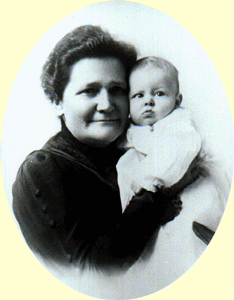
Janneta Bliss
|
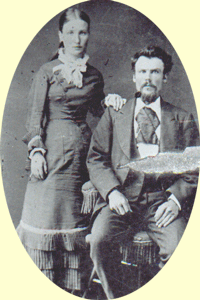
Zona and John Cappell
|
While Jenny did not have any siblings that I know of, Will had two
sisters, both of whom had that wonderful red hair. Zona married John Cappell
and they had six children, all of whom were in Northern California; I remember
visiting Elmer Cappell one summer. The other sister, Eliza, married Abe
Snyder and they had two children. I never met Eliza or their children,
but Uncle Abe came to visit us when he was in his nineties. He lived in
Westport, which is on the coast opposite Laytonville. He was a wonderful
character and your Dad loved listening to him and laughing that great laugh
of his.
My maternal grandparents were married on July 2, 1884. He was Justice
of the Peace in Ukiah before they moved to Sherwood Valley and went into
the timber business. They had five children, four who lived. Earle was
the oldest, then Joe, followed by Mildred, known as Midge to us, and my
mother, Jenneta Eloise. Reta lived for only five days, and I do not know
when she was born, before or after my mother. Mom was born in the tiny
town of Laytonville, north of Ukiah and just south of where the mountains
begin. It is still very small, which is rather surprising as it is on 101,
on flat land, in a beautiful valley. Perhaps the land is privately owned
by ranchers or farmers. Oddly, I do not know where the others were born,
other than it was in that same area. |
The family lived in various places besides Ukiah; Kelseyville, Cloverdale,
Willits. Will knew everyone in the area and kept track of most of them
over the years. Admiral Stanley went to school with him— he served
as ambassador to Russia as well as serving in the Navy, and after his death,
a state park was named after him. I never met him, though I did read letters
he wrote to my Grandad, but I did know Josie Van Damme and a state
park was named after her family as well. She was such a good friend of
my Nana, and when she lived in Oakland, Mom and I would visit her. She
had the most beautiful marbletop tables and also a Stradivarius violin.
If I had been willing to learn to play it, she would have given it to me.
But I hated the idea, thinking people would laugh at me — and I didn’t
know the value of it!!! And with my short arms, I probably wouldn’t have
been able to play it anyway! And her family probably wouldn’t have let
us have it anyway, when she died; they didn’t let Mom have the marbletop
table she had been promised.
| My mother’s life as a child must have been a bit rugged and even tough,
but listening to her stories about it brought in the fun and adventure
of living in what to us now would seem a wilderness! There were none of
the amenities that we consider absolute necessities in our lives— no bathrooms,
electricity, refrigerators, at times no running water— perhaps they had
ice boxes, but I am not sure where the ice would have come from. I have
heard of places where people would cut big chunks of ice during the winter
and keep them in deep holes in hopes they would last for the hot weather,
but I don’t know where anyone would find any great amount of ice in the
area where they lived — unless they took wagons to Mount Shasta! They did
have ‘coolers’, a screened-in hanging box which was on the north side of
the house. As I write this, I laugh at all the precautions we get about
refrigerating food — Jennie used to make cream pies and put them in the
cooler — during the 1906 earthquake in San Francisco, all the cream pies
upset, so she gave them to the Native American woman who worked for her.
Soap was made with fat and lye — it had to sit until it jelled -- bread
was made with flour that came in printed sacks that were then used for
clothes— some of the material in the quilt from then was flour sack— meat
was salted and dried if not able to be used up in the warm weather. There
were root cellars where the food grown in the summer could be stored in
winter.
Traveling was done by horse and wagon— no cars of course and the trains
didn’t go everywhere- and I don’t know that they had bicycles— it would
have been rough biking anyhow. They walked miles to go to parties or went
by horse and buggy or wagon to go to parties where they would spend the
night and go home the next day because of the distance. |

Nana Snell, baby Bob and Margaret
|
The food was like ours except that they grew and made and hunted and fished
for much of their food — milked cows (and made butter from the cream).
Mom learned how to catch a fish with a horsehair, as the natives did. This
all, of course, changed as time went by and they moved into towns where
there were stores and bakeries, etc. But nevertheless, Jenny continued
to make the dresses and shirts, bake bread, bake pies, smoked meat, canned
fruit and vegetables after growing them; she was a wonderful cook and taught
Midge and Neta to be the same.
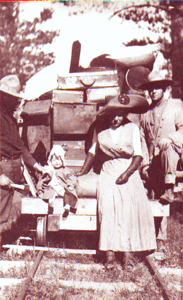
My mother and her brothers
|
I think my Nana was a strong woman. She probably had to be, living in
a somewhat untamed area in California. She worked hard, but she also did
beautiful handwork — she tatted, did all kinds of needlework, cut work.
And she was fun! She looked like a grandmother, soft and plump. She and
I played card games and mah jong, the latter with others, particularly
my mother (this is another thing my father gave away, the beautiful ivory
mah jong set!!).
Will went through six grades in school and perhaps there weren’t any
higher grades to go through, I don’t know. I do know that it didn’t matter
so far as being able to get a job. He did many things, but what I remember
personally is his being a timber cruiser. This required him to go through
forest belonging to the Southern Pacific Railroad and estimate how many
board feet a particular tree would provide. He was remarkably accurate
in being able to just look at a tree and know; in fact, he became so well
know that even after he retired, he was called back over and over to cruise
for lumber companies. When he was younger he had been a lumberjack and
was part of the harvest of the ancient, immense redwoods, which we strive
so hard to protect now. He really knew the forests and nature and I have
a feeling that he would not have been for clearcutting as it is done now,
leaving moonscapes behind. We have a couple of pictures of him and others
cutting trees— most of the trees that were that big and old are gone now,
although, luckily, some have been protected by being contained in the park
system. |
He was very psychic and would have precognitive dreams. The one I have
always been struck by was one he had of stepping over a downed log onto
a rattlesnake. The next day, while cruising, he came to a log, looked on
the other side, and there was a rattlesnake! He also would dream of being
in a rowboat with a member of his family — both out here and back east—
the boat would tip over, and either the relative would be saved or would
drown. He would later hear that the particular relative had died or had
been very ill but had recovered.
This gift (or curse, depending on one’s point of view about seeing the
future) ran in his family. He had a Cousin Jane, who lived in Hollywood
and was consulted by the stars of those days before they would sign a contract,
etc. Mom, Dad and I went to visit her when I was about twelve, I think.
Dad was a sceptic but she took him in another room and told him things
about Mom’s health — and they were true!! I never knew what they were,
but I do know she had some surgery not long after. She wouldn’t do a reading
for me as I was so young, but she did look at my palm and tell my parents
that they would never have to worry about me. I guess she was right!!
| I don’t know exactly when they lived in Cloverdale, but you remember
the house there that we would see when traveling north— and Peg and Becky
went up to one time, horrifying Jessica. I didn’t go in, either, though,
and I will say it was fun to get a report from the two of them.
Jenny and Will each seemed to be particularly close to two of their
children — Jenny was closer to Earle and Midge; Will, to Joe and Neta,
although they were a close family. They got along well, and we have some
great pictures of them growing up and as young adults— Joe had the same
interests as his father, being an outdoors man; Earle was a writer. Midge
never married and stayed with her parents, which was great for Jenny as
Will would be gone a lot. My mother felt that her mother kept Midge from
marrying, but we know that no one can make us do something if we really
don’t want to!
Having known this family only as adults, of course, it is hard for me
to imagine them as children. But from the stories Mom told, they were like
children of all generations — into trouble, playing games, teasing, learning.
Earle went to UC when it was only in Berkeley; Midge and Neta went for
a time— in fact, your Nana took a year of landscape architecture. Remember
her gardens? |
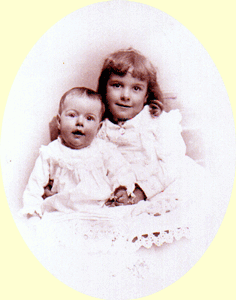
Midge and Neta
|
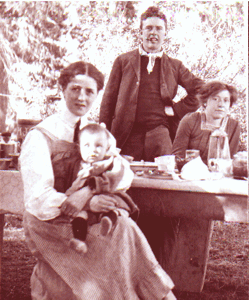
Joe's 1st wife Ollie & Margaret
|
I don’t know if Joe went to college at all. He was a man who did lots
of different things: he was a lumberman, the sheriff at Yreka, a deputy
several places, a carpenter who did beautiful work, a guard at San Quentin
(which didn’t last long because it was such a cold-hearted job and he was
anything but that!). He became a contractor and settled in San Rafael,
had a boat in a marina just below his home. I don’t think he was as close
to others as they were to each other, although he and Midge may have been
fairly close— I do know that the ‘family scandal’ stayed important in my
Nana’s and Midge’s minds and they may have found it hard to feel close
to Olga. They were so fond of Joe’s children from his first marriage, particularly
Bob. But I don’t think they were that fond of Ollie, either, perhaps because
if she had gone with Joe, Olga wouldn’t have happened. Incidentally, Ollie
moved down south to Fullerton, had a store and became very successful!
We would see her when we went to visit Earle and Jess, and her children
were around us quite often, particularly Margaret and Bob.
I don’t think any of you met Joe’s sons, Bob and Jack, though I know
Bob came to that family re-union at Neta’s in Palo Alto. You did all know
Margaret and her husband, Irwin Moon. What a remarkable man — had an honorary
PhD bestowed on him for his scientific work. He was a Baptist minister,
unlike any other minister I have ever known! Margaret was always a very
quiet and after marrying Irwin, became a stereotypical minister’s wife.
They had lots of children, then grandchildren, then great-grandchildren.
He was amazing— developed time-lapse photography; developed some machine
that could pick up the sound of molecules in wood, etc., and at the World’s
Fair on Treasure Island, had an exhibit where he would stand on electrical
coils and have one million volts of electricity come through his fingers
— it would look like lightening. |
Do you remember them coming to Bothin about the time of your wedding, Becky,
and offering to take everyone out to dinner? Ended up with all the kids
who had come out from New Mexico and were staying with us — sixteen of
us, I think! They came up another time to pick up one of the redwood burl
tables Joe had made. Mom had one, that I now have, and he made one for
Midge, which Mom had after Midge died. I felt Margaret should have it,
so she could have something her father had made. She was very touched by
it. Irwin took some wonderful pictures of Steve and Jessica at that time.
He was such a good photographer; once when we went to visit them with Bill
and Barbara and family he made duplicates of the old family pictures so
everyone could have copies.
Earle was a lovely, absent-minded film writer, gentle and non-aggressive.
His wife, Jessie, who had been married before and had a daughter, had lived
in Coalinga, a small valley town. How the two met, I have no idea--actually
had never thought about it before! But it is fun to suppose that somehow
she was in Reno while he was there, and she was playing blackjack and he,
in his absent-minded way bumped into her and that was it! She ran their
life and spent money so easily and therefore they ended up with little
to show for his salary --$1500/week as I recall Mom saying— which was a
lot in those years. He seemed very happy and content with it all and he
was deeply loved by Margaret, his step-daughter and her husband, Jess Hibbs.
I loved visiting them; it seemed very glamorous and exciting and Jess always
showed us such good fun— the beach, the Farmer’s Market. They lived in
a house, on Olive Street I think, which had been Gloria Swanson’s home
once. Earle made bathtub gin during prohibition and there were always poker
games (that I heard about but never was at) attended by film people. One
was Pat O’Brien; Margaret said Pat only recognized her when he was drunk,
but never when he was sober. When WWII started, Earle wrote scripts for
the government. What a nice man! When he stopped working because of his
health, Jess started teaching at a school for children in filmdom. She
was quite elegant and cultured, at least on the surface. She was quite
caught by money, social status, and --men! But exciting to visit, when
I was young and impressed by Hollywood.
| Jess Hibbs, Earle and Jess’s son-in-law, was a terrific guy — we all
liked him so much. He had been an All-American at USC, along with Marion
John Wayne. John Wayne was Jess’ best man at his wedding. Jess, of course,
was in film work, too, and at the time of the marriage was an assistant
director. He graduated to full director, directed Audie Murphy in some
of those films. I believe Earle wrote one of the scripts (his specialty
was "oaters"). Jess also went into television and did a number of the Perry
Mason series. A side story — Jess had played so much football that at times,
when he was asleep, he would tackle whoever was in bed with him. One time
when they were visiting us, for some reason he and my father were in the
same bed and every time Dad moved, Jess would tackle him! So Dad was as
quiet as he could be!
Do you remember Midge? She was quite a lady in many ways— pretty, smart,
capable. She adored Joe’s Bob and my sister, Peg. I was not one of her
favorites, perhaps because I was my Nana’s favorite! Not that Midge was
mean to me, but she obviously preferred Peg. She and Mom were very close
as they grew older, and she was around us a lot. She worked in Los Angeles
or Hollywood, at The Broadway, I think it was, and would come up on the
Lark, the night train, and arrive on Christmas day. We would have to run
by the room with the Christmas tree in it and go meet her train, then go
back to open presents. And have breakfast, which was always biscuits and
chipped beef gravy — one of your Dad’s and my favorites as it is of Peg’s
and maybe Bill’s and Becky’s, too! |
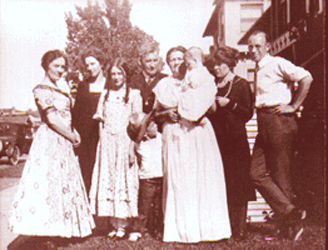
The Snell Gang
|
She was very successful in merchandising, and was a buyer in Notions —
I am not sure what that is and that department probably doesn’t exist anymore
under that name — I think it was buttons and lace and that type of goods.
She went to Paris each year to buy for the next season and that always
seemed to glamorous to me! I remember she brought back little chocolate
bottles filled with liqueurs. She made a good deal of money, but she had
a long time dream of owning a restaurant. So she quit her job and opened
a series of restaurants. She had her first one in San Anselmo — why there,
why she and Grandad and Nana were there, I can’t remember. The house was
on Magnolia, and my grandad took care of Nana there— she had had a severe
stroke when I was about twelve and was paralyzed on her right side.
I need to go back to the time my Nana had this stroke— it had a long
time effect on my family. She and I had been playing cards — casino, I
think — we did so many things together — traveled on the train, read, played
cards,; she made many of my clothes. The next morning Mom awakened me and
called me to where Nana was in bed. She couldn’t talk and I didn’t understand
what was wrong. They took her to the hospital and I didn’t realize it at
the time, but she must have been expected to die, because the whole family—
her family as well as mine— were in her room. She was tough, though, and
pulled through. She had a remarkable medical history, having had eleven
major surgeries — I don’t know what — though I imagine most surgeries were
major in those times, and she had come close to death often. Mom told me
about a time when she had been given up on and she insisted on the nurse
bringing her some peppermint tea. The nurse protested, saying, "Jennie,
you won’t be able to keep it down", but Jennie insisted. She didn’t keep
it down but it brought her back to life!
After she was able to leave the hospital, she came to live with us on
Spruce Street, and there was a nurse who came in every day to take care
of her, as she was unable to do anything for herself. This is when your
Dad would take her for rides on Sundays. He would pick her up and carry
her to the car, and off we’d go — my Mom would always go— not for long
rides, but at least it was a change for her. Eventually, and for what reason
I didn’t know — my Nana went to a nursing home in Oakland. I remember going
to see her. I also remember that one time Mom went, there were ants all
over the bed and other things that made it impossible to leave her there.
Perhaps that is when Midge and Grandad moved to San Anselmo to take care
of her. (If people only realized how hard it is to remember things, we
would start taking notes every day— this is all pretty mixed up in my mind.)
Nana was in a hospital bed by the big picture window so she could look
out. I guess she wished she hadn’t lived after the stroke, because she
tried to throw herself out the window— and of course wasn’t able to.
The restaurant in San Anselmo was quite successful — it was on San Anselmo
Avenue, right by the bridge over the creek that led to the commuter train
station. She was a wonderful cook and my grandfather went down every morning
to make sour dough pancakes and biscuits — which he had made during his
timber cruising days. The commuters loved them
Then came a place in Mill Valley, up above where the Starbucks coffee
place is now. A bit more elegant than the first place — which was her dream
— a dining room with wonderful continental food. This place always is special
to me because this is where your father first asked me for a date!! We
were celebrating birthdays — Peg’s, Mom’s, Dick’s and mine — and after
dinner, we had gone downstairs to dance in the street — honestly!! And
he asked me to go to a movie the next night — was I ever thrilled!! More
on that later — this is about Mom’s family.
The next place she opened was on Grand Avenue in Oakland, by Lake Merritt
— an old house that had been made into a restaurant as well as a residence.
It was close by the big apartment house on the lake where they had lived
some time before, after they had left the ‘ranch’ in Sacramento. This was
also the place where I (and Peg) had to help out by waiting on tables.
How I hated that, really hated it!! I did get big tips because I was so
little, and the men would help me with the trays and leave big tips. But
I hated it!!! My grandfather at this time had a heart attack and was
never well after that. He came to live with my Mom because he was happier
there and also didn’t worry so about Nana. Mom had to put him in the hospital
because he started wandering at night and could have fallen down the stairs.
It was a hard time for Mom. And Nana needed to be put into a nursing home
— in Berkeley, but it was a really nice one, and she could see out the
window and wave to the students from Cal as they went by. And we would
go see her as often as we could. My sister took Dan, her oldest son, to
see her when he was very small, and for some reason he called her B-Nana.
She loved seeing him.
I wrote that Nana’s stroke had a long term affect on my family — the
idea of having a stroke haunted Mom, and she worried about someone having
to take care of her — and told me that if she did have a stroke, I should
not feel bad about putting her in a nursing home. And then she did have
a stroke and I had to put her in a nursing home, and she refused to believe
that she had had a stroke — kept wanting me to take her for a walk in the
hall. It was hard on me!! Then when my sister had a heart attack and got
pneumonia, and was really out of it, a breathing tube down her throat—
everyone was trying to figure out why she was so sort of frantic — and
when I came to see her, I knew, and I told her that no, she had not had
a stroke and she was not paralyzed. And she relaxed. I used to be worried
about having a stroke — and maybe I will, someday — hopefully not, for
all your sakes — but being with Mom in a really nice place — it was fine
and she was happy. They loved taking care of her because she was so happy!
That was sort of an aside that I just took, but now I shall return to
Midge’s restaurants!
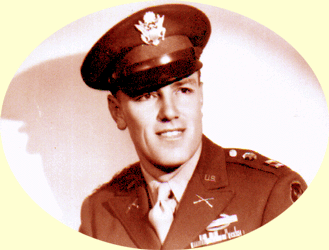
One handsome dude!
|
During the war Midge started working for a caterer in Oakland, both
because of rationing which made it almost impossible to obtain foodstuffs
enough to run a fine restaurant, and also because this caterer was doing
a lot for the USO center in Oakland. In fact, Midge went to the Center
quite often to help feed the many military people moving through the Bay
Area. It wasn’t just a matter of feeding them — it was also a matter of
letting them know that even though they were far from home, and on their
way to fight the war, people cared about them. There were so many of them
— this, of course, was a staging area for the Pacific front. Troop ships
were leaving every day; troop trains of many cars arrived every night —
which made for dramatic sights during the blackouts — we lived up in the
Berkeley hills and the sirens would go off and we would see the lights
go out, one section at a time, and then we would see the headlight of the
engines moving along the tracks — and a short time later, the lights would
suddenly flash back on! (One of those silly things of the war — it was
as if we kept the lights off, any spies around wouldn’t be able to tell
a troop train was arriving!!) I went to the Center several times with Midge
— it was quite a moving experience — they were so young!!
Midge was still working at the caterers when Dick came home from overseas
— and she brought a feast for us all — Peg and me, sister Peg and Dan and
Steve, and Midge plus Dick — to celebrate his return. But that’s another
story! |
There is a well-known restaurant in Mill Valley— small, intimate, elegant
— El Paseo — so named because it is on a passageway between two streets.
Midge started it after the war. It became quite famous for her specialties,
steak and kidney pie, beef wellington, popovers and, your Dad’s favorite,
fresh coconut cream pie! (I have the recipe!)!! It must have been difficult
then to know how much food to buy — no freezers, so chefs had to guess
amounts. And have specials to use up what needed to be used up before having
to throw it out. She loved it and didn’t mind all the work. Isn’t it funny—
I can’t remember where she lived then, probably in a Mill Valley apartment,
but I simply cannot picture it. She was ill at one point so that she couldn’t
work and Mom and my brother, Henry, ran El Paseo for her — which was fine
because your Nana was as good a cook as Midge.
Midge died too early — sixty years old. She had always had a problem
with her weight because, probably genes but also loving food so much. She
would go on a diet but then make wonderful pies and cakes and put ice cream
on them! She loved feeding Dick because he so loved to eat!
My brother, Henry, took her to visit the Zeiferts in Fresno (more about
them in another part of the story) and after dinner she had said she was
tired and wanted to go to bed. When Peggy Zeifert went in to check a bit
later, she realized that Midge had had a massive stroke. She never even
woke up.
She could have had an easier life if she had stayed in merchandising,
but she knew what she needed to do for her own being, and did it. When
she died, Mom sold the restaurant and so that phase of life ended. And
with a bit of bad taste in it all — the waitress Midge had hired and treated
like a daughter, stole her recipe book, which held no only the recipes
used at El Paseo, but also those that had been in the family for years
— and used the popover one to sell frozen ones to markets!! Mom had no
proof and besides didn’t want to make a fuss about the place Midge had
so loved.
| As I have written — and you already know — Mom lived in a number of
places in Northern California, but probably Ukiah was the main home for
the family. They lived there during the 1906 earthquake, which was called
the San Francisco quake, but the epicenter was north of the City, near
Santa Rosa, I think. It shook Ukiah enough to cause a good deal of damage
and left wonderful stories about the earth opening up and swallowing cows
and then closing again — perhaps true, perhaps not. I don’t know when her
family moved to Berkeley, but probably when it was time for Earle to go
to Cal. My parents met there, where he was in college; he had dated Midge,
but when he met Neta— that was it! He didn’t get to finish college, which
he had started at age sixteen, because his father died and he had to go
to work to help his mother. Sad perhaps as he so loved learning, but it
didn’t stop him from teaching himself. He had a genius IQ, 187, and was
one of the most learned persons I have ever known. Mom was very intelligent
as well, with no doubt a way above average IQ, but the Bailey family always
considered themselves smarter than anyone (brother Bill still does!) —
and never felt the in-laws were worthy!
Neta and Hal were married on Friday, February 13, 1915 — so the superstition
about Friday the thirteenth has never held much power for me. They were
married in a house on the corner of Rose and Spruce Streets, which is still
standing, a wonderful brown shingled house, the last time I went by there,
when we took Jess over and showed her all the houses we had lived in while
growing up. It was a lucky day for me and my siblings — wonderful parents
who gave us good and healthy childhoods — not perfect, but full of love
and fun. |
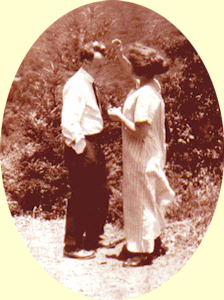
Neta and Hal get engaged on Mt. Tam
|
Return to Marin County
Genealogy - History








